
Lygodium is a genus of about 40 species of ferns, native to tropical regions across the world, with a few temperate species in eastern Asia and eastern North America. It is the sole genus in the family Lygodiaceae in the Pteridophyte Phylogeny Group classification of 2016. Alternatively, the genus may be placed as the only genus in the subfamily Lygodioideae of a more broadly defined family Schizaeaceae, the family placement used in Plants of the World Online as of November 2019.
British NVC community OV5 is one of the open habitat communities in the British National Vegetation Classification system. It is one of six arable weed and track-side communities of light, less-fertile acid soils.

Microstegium is a genus of African, Asian, and Pacific Island plants in the sorghum tribe within the grass family. Browntop is a common name.
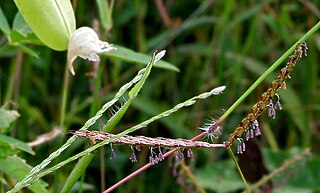
Ischaemum is a genus of plants in the grass family, widespread in tropical and semitropical regions in many countries. Many species are known commonly as murainagrass.
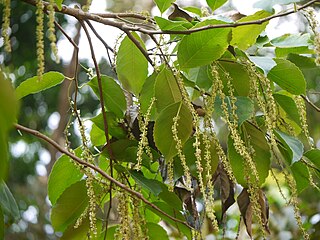
Homalium is a genus of plants in the family Salicaceae.
Homalium polystachyum is a species of plant in the Salicaceae family. It is endemic to New Caledonia.

Digitaria ischaemum is a species of crabgrass known by the common names smooth crabgrass and small crabgrass. It is native to Europe and Asia, but it is known throughout much of the warm temperate world as an introduced species and often a common roadside and garden weed. It is an annual grass producing an inflorescence with two or more narrow branches lined with tiny spikelets.

Apluda is a genus of plants in the grass family native to Asia and to various islands in the Indian and Pacific Oceans.
Sehima is a genus of mostly Asian and African plants in the grass family.

Spodiopogon is a genus of Asian plants in the grass family.
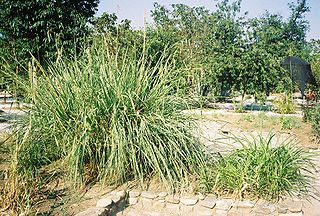
Tripsacum is a genus of plants in the grass family native to the Western Hemisphere. Gamagrass is a common name for plants in this genus.

Tetramerium is a genus of plants belonging to the family Acanthaceae. It is found mainly in the Americas, especially in tropical dry forests. Christian Gottfried Daniel Nees von Esenbeck first described the genus in 1846 after collecting two species on the journey of HMS Sulphur.

Marimatha nigrofimbria, the black-bordered lemon moth, is a moth of the family Noctuidae. The species was first described by Achille Guenée in 1852. It is found in North America east of the Rocky Mountains and in Arizona and California.

Bothriochloa ischaemum is a species of perennial grass in the family Poaceae, found throughout much of the world. It is commonly known as yellow bluestem. Two varieties are recognized, of which Bothriochloa ischaemum var. ischaemum is native to Europe, Asia, and Africa and naturalized elsewhere, and var. songarica is native to Asia and naturalized elsewhere. Var. songarica is an invasive weed in Texas, where it is known as "King Ranch bluestem"; it has displaced native grasses in large areas of central and south Texas.
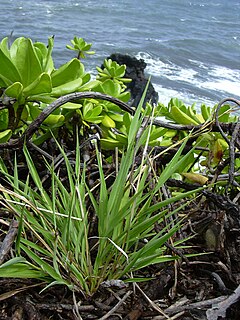
Ischaemum byrone is a rare species of grass known by the common name Hilo murainagrass, or Hilo ischaemum. It is endemic to Hawaii, where it is present on Kauai, Maui, Molokai, and Hawaii. It was known from Oahu but it is now extirpated there. There are perhaps 1000 to 3000 individual plants remaining in total. This is a federally listed endangered species of the United States.
Ecological succession can be understood as a process of changing species composition within a community due to an ecological disturbance, and varies largely according to the initial disturbance prompting the succession. Joseph Connell and Ralph Slatyer further developed the understanding of successional mechanisms in their 1977 paper and proposed that there were 3 main modes of successional development. These sequences could be understood in the context of the specific life-history theories of the individual species within an ecological community.
Ischaemum jayachandranii is a species of perennial in the family Poaceae. It is found growing in marshy areas and in the rice fields of Kannur district in Kerala, India.

Koenigia polystachya is a species of flowering plant in the knotweed family, known by the common names Himalayan knotweed and cultivated knotweed. It has several regularly used synonyms, including Polygonum polystachyum, Aconogonon polystachyum and Persicaria wallichii.
Sphenomorphus darlingtoni is a species of skink. It is found in Papua New Guinea.
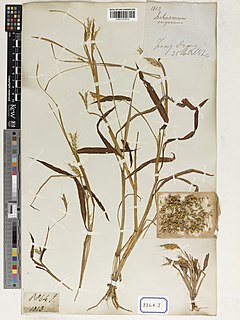
Ischaemum rugosum, also known as saramollagrass, is a flowering plant belonging to the grass family Poaceae in the genus Ischaemum, and is native to tropical and temperate regions of Asia, growing in marshes and other wet habitats. It is a vigorous annual, and is an invasive species in South America and Madagascar. It reaches heights of up to 1 m and is primarily recognized by the ridged surface of its sessile spikelet’s lower glume. Despite its historic importance as fodder in Asia, the grass has become a major weed in mid-latitude rice paddies throughout Asia and South America.













